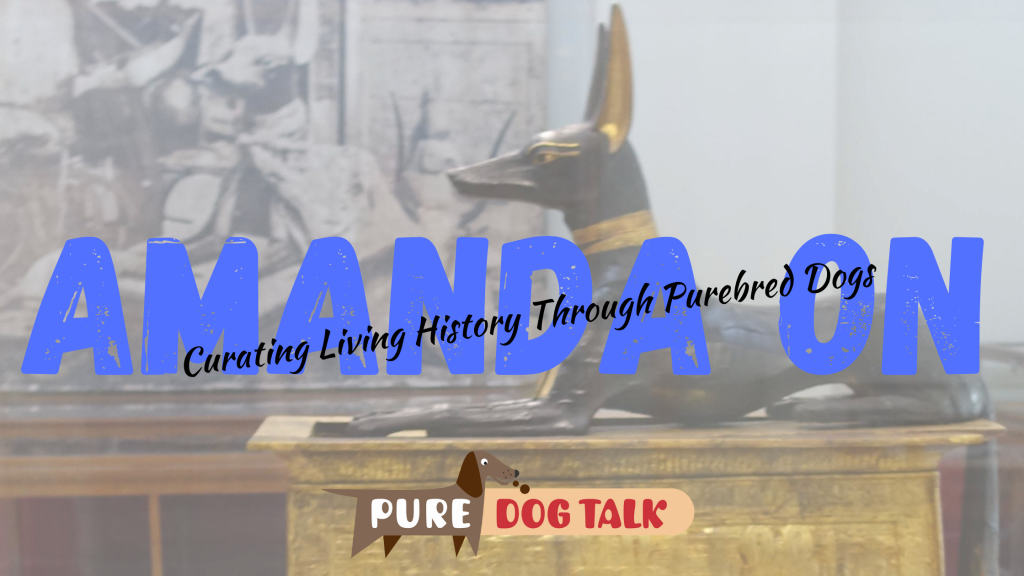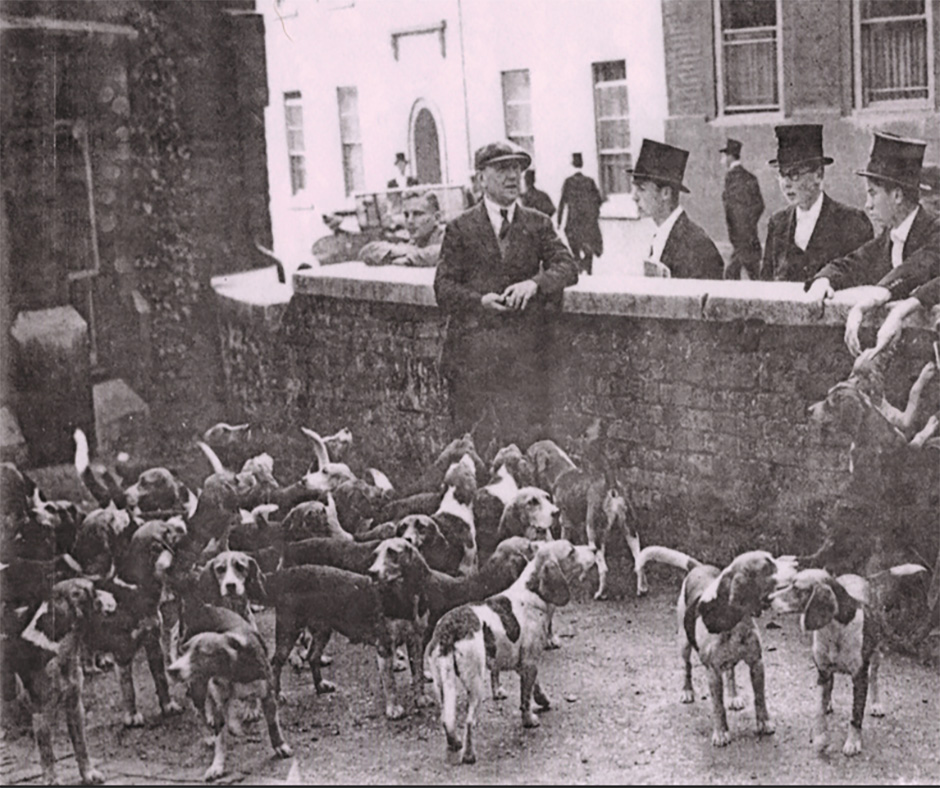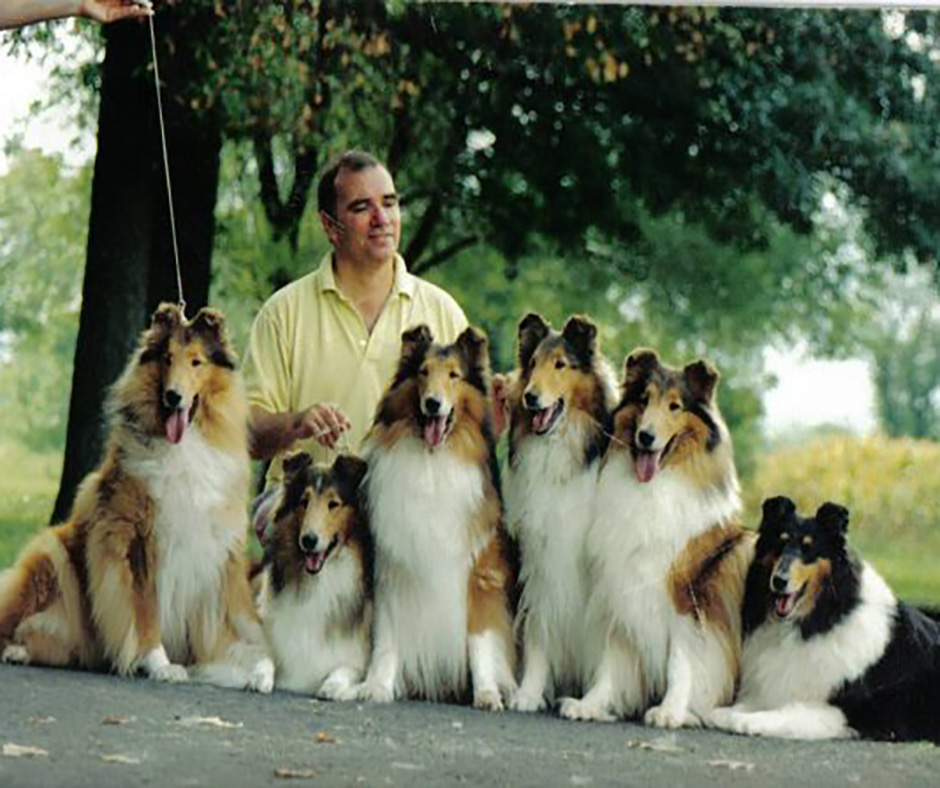643 — Bo Bengtson on Whippets and His Newest Book
Host Laura Reeves is joined by Bo Bengtson, legendary breeder, judge and author of The Whippet: An Authoritative Look at the Breed’s Past, Present and Future.
Questions for Bo:
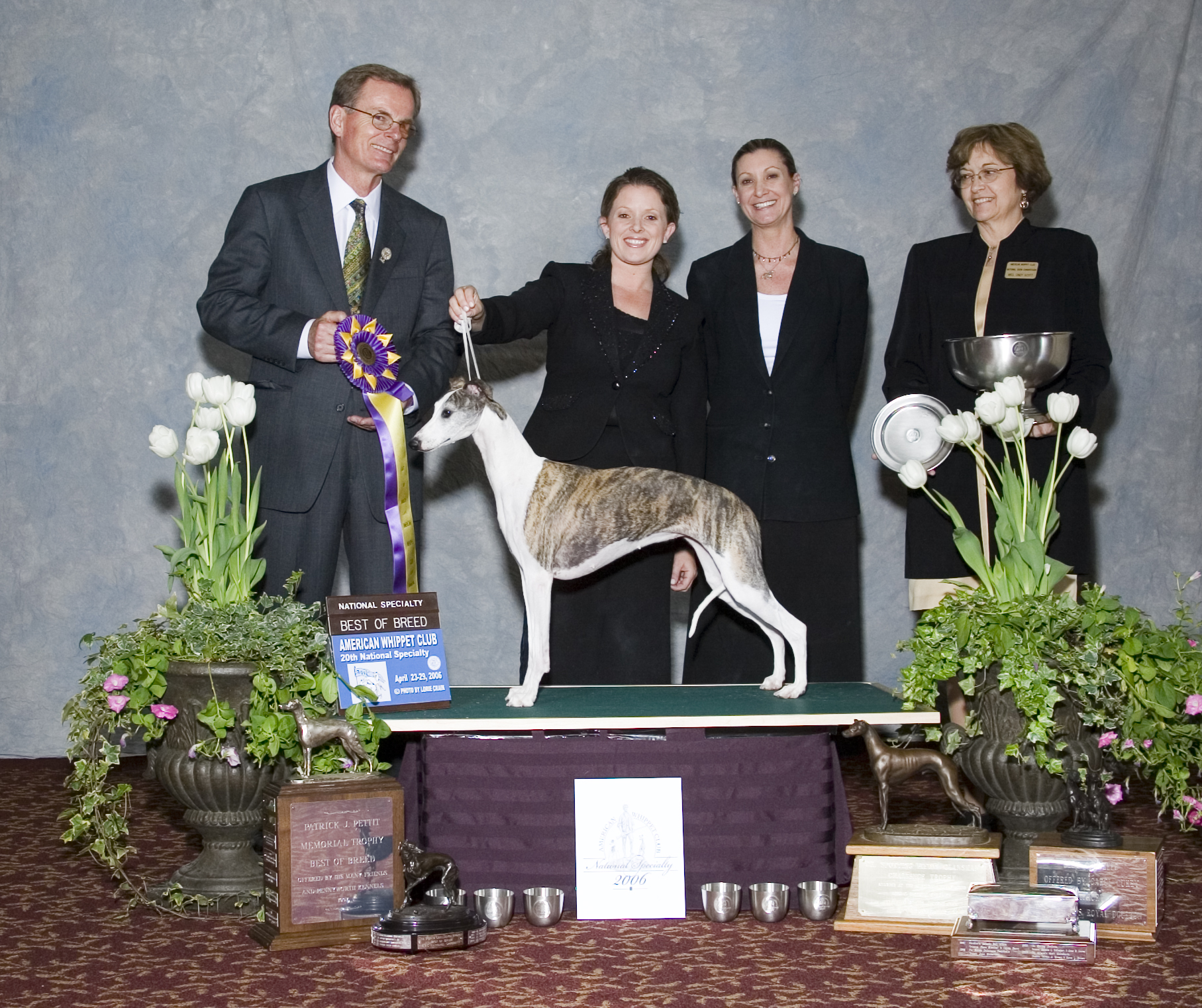
Bo Bengtson judging the American Whippet Club National Specialty.
1) This is your fourth edition of the quintessential book, “The Whippet,” first published in 1985. What made you want to update it again? What will readers find that is new?
I guess it’s pretty unusual for a dog book that was published that long ago to be reprinted, but it was last published in a much enlarged edition in 2010 and so much has happened in Whippets in the last 15 years! Whippets have become one of the most popular breeds at many shows: Crufts in England has had about 400 for the last few years, only Labs and Goldens have more… I have judged a show with 250 Whippets in Sweden, they have a Sighthound show in Germany that has 235 Whippets as a top figure, and it has become amazingly popular in many countries where you wouldn’t necessarily expect it: the big shows in e.g. Poland all have more than 100 exhibits NOW. The 2024 FCI World Dog Show was held in Croatia last month and there were 171 Whippets entered, which is fairly typical figure for the World Shows. And there are over 6,000 entries from the Czech Republic alone to the Internet’s Whippet Archive, so that’s probably the next big Whippet country!
USA doesn’t have the biggest registration figures, but the American Whippet Club holds a National Specialty in April every year that is the largest in the world, sometimes with more than 600 Whippets present and over 1,200 entries. I made a point of including all countries that have affected the world population in some way. Did you know that there is a world class Whippet breeder in South Korea that often wins in Europe and works with American bloodllines?
I read parts of that 1985 book recently … It’s not a bad little book for its time and a lot of the content is in later editions also, but it’s fairly typical of breed books then, both in scope and size. Not many photos and all black and white, but I’ll always remember how proud I was to get into Foyles Bookstore on Charing Cross Road in London and seeing my book on the shelf there!
To get back to the new book, I’m so grateful that Denise Flaim convinced me to update it! The book is available both on Amazon and via Denise’s RevodanaPublishing.com —they did a beautiful job: the book is much bigger than I expected — I don’t know why I didn’t expect that because I know that we added a lot of text and about 200 photos of winners from the last 15 years. Anyway, it weighs about 3.25 pounds, covers 530 pages, and when I took an advance copy to the National specialty in Tennessee in April, one reader actually started to cry because it was so beautiful!!
2) Share with our listeners some of the fascinating breed history you have gathered over the years, from its humble beginnings hunting hares, to its popularity as “the poor man’s greyhound,” to today.
Well, of course the Whippet became popularly known as the favorite dog of the poor mining families in the North of England in the 1800s. There was organized racing with considerable sums to the winners, so of course the dogs were really well taken care of and in fact fed much better than the people. What’s really amazing is how many people turned out to watch the races: there are some grainy black and white films still in existence from the late 1800s, and they prove beyond a doubt that there were thousands of spectators, many thousands.
But what I’ve found was that the Whippet had friends much higher up on the social ladder as well. Gertrude, the Lady Decies, was socially very prominent and owned several champion Whippets, including the two first brindle champions. She was primarily a cat fancier, breeder and exhibitor but she showed the dogs herself, in post-Victorian voluminous skirts and cartwheel hat. And there was also Sir Edmund Chaytor, Bart., who was a frequent exhibitor with Lady Chaytor and helped reorganize the Whippet Club after the first World War.
There are even some royal connections: in Kitty Kelly’s biography of the British royal family there is a previously unknown photo of Queen Mary with three of her sons, dating from perhaps 1910, which has a very good-looking Whippet in it: I have not been able to find out the name of the dog, but Queen Maud of Norway, who was born in England and granddaughter of Queen Victoria, was often photographed with her Whippets.
So I think that the Whippets has gotten a somewhat unfair rap for appealing only to one particular segment of society while in reality it was appealing both to high and low.
3) Talk about the Whippet internationally and the cooperation amongst breeders that has made it one of the deepest in quality globally.
There are differences between the standards in U.K. and in the U.S., but they are not greater than that a really good dog can win in both countries. The days when you almost needed an English Champion to win in the U.S. are long since gone, and the English added some American blood since then, which was quite successful, but mostly they import from Continental Europe these day – and Europe is full of fantastic Whippets of part English and part American breeding these days … The Europeans are almost more American than we are in the U.S. — and they LOVE American imports!
I must give shout-out to Italy, which has some wonderful Whippets and probably five or six word-class breeders, and Holland, who has a long history in the breed and currently houses Europe’s probably most successful stud dog, — who was born in South Africa of part British and part American background. The most successful breeder in England actually lives in Holland!
4) What other factors can you identify that account for the depth and breadth of quality in the breed?
I mentioned the Internet’s Whippet Breed Archive earlier; it has more than 372,500 pedigrees online — I just checked! — many of them illustrated. It’s an incredibly important tool for both novices and longtime fanciers like me, and everybody uses it. You can find statistics, both current and from the past, about things like population, color distribution, health, and the most popular sires, and you can even make up mock pedigrees for planned litters. I really think the success of the Whippet Breed Archive has been the success of the whole breed world-wide!
And there are so many different competitive outlets for Whippets, which probably accounts for much of the activity in the breed and explains why we lose so few new fanciers. You can focus on conformation, of course, but there are also field activities that you can participate in: racing or coursing, and we always have a couple of days of field activities during our national specialties, and sometimes there are the same dogs who participate. There were 200 entries in the coursing alone at the 2024 National, and 50 of them were conformation champions! And at the National Specialty there are invariably special classes for those who are racing or coursing qualified, and a special award to the winner of Best Performance Dog. Then you can of course participate in obedience or rally, like hundreds did at our last national specialty. And there are always well-filled Versatility and Triathlon classes!
5) What are Whippet breeders doing that the rest of the purebred dog fancy could learn from?
The fact that we have a really great, large and strong National Specialty is really important, I think. The Whippet people more or less take over a hotel or motel in a different part of the country in April every year, and beyond national specialty judging there is so much going on that there is no way you can participate in everything: there’s racing and coursing, Breeder’s Sweepstakes, Veteran’s Sweepstakes, Futurity, Top 20, health testing, judges education, parades of Honors and Rescues … and probably even more that I’ve forgotten, like obedience, agility and rally. … It gives people something to focus on; I’m really sorry for the breeds that don’t have a great National Specialty.
And it probably helps that we are as a group generally NICE! There are some exceptions, of course, but when I hear what goes on in some other breeds I am so grateful that I’m in Whippets! I doubt that anybody would refuse to let their stud dog be used on some bitches because they just happen to be owned by the “wrong” people, and if someone would like to buy a promising show puppy from another kennel, just let them. There is the usual grumbling about the wrong winners, of course, but I bet there’s less rancor and bad feelings in Whippets than in most breeds. We really try to be happy for each other when somebody is winning, even if it isn’t what we would have done if we were judging,
6) Can you identify and talk about three quintessential, iconic “lines” or families or kennels of Whippets, either standing alone or working together, that have most influenced the modern breed?
English Laguna: a son of the great stud dog Laguna Ligonier was sent over to the U.S. in the 1960s, Greenbrae Barn Dance, and basically created the American Whippet. He was an incredibly strong sire for his own elegant type, and his litter brother was exported to Canada: the sheer beauty of these dogs and their offspring was overwhelming; they were saved from an over-refined appearance by the strength of the Stoney Meadows more genuinely American line — bred by Mrs. Wear, Doris Wear.
And of course there was Peggy Newcombe and her Courtenay Fleetfoot of Pennyworth, who did wonderful PR for the breed by winning BIS at Westminster and being No. 1 dog of all breeds.
Later there was Ch. Delacreme De La Renta, who was a terrific sire, and his grandson Ch. Starline’s Reign On: both have sired well over 100 champions each, and Reign On is in the news again now for having sired many more champions in a couple of litters by A.I.
We are lucky to have so many clever breeders in pretty much all areas of the country, which makes it difficult to win with mediocrity anywhere. Sporting Fields has bred many litters, often in partnership with other breeders, but they have the number of champions for it, and six Sporting Fields dogs have won the National Specialty! Or seven if you count Ch. Bo-Bett’s Air Force One, who won in 2023 – he was officially co-bred by the late Carol Harris with Debbie Butt and her daughter Amanda Giles.
There are so many other kennels and stud dogs that have had breed-changing influence, like Starline and Chelsea and Plumcreek and Saxon Shore that it’s impossible to mention them all.
7) You have judged all over the world for decades. Name three dogs you have seen that you most admired and what made them stand out in your mind. Of the many beautiful Bohem whippets you’ve bred, which was your favorite?
Oh, that’s very difficult … Some of the dogs I’ve put up in Europe and Australia have been wonderful, but the best Whippet I’ve judged remains Ch. Brushwood’s Moxi of Endeavor in the U.S., who’s a perfect balance of elegance and strength. She should have won many more BIS than she did, but she won the AWC National three times, once under me.
I haven’t judged the Crufts BIS winner Ch. Pencloe Dutch Gold, who was wonderful and whom I got the opportunity to go over when he was shown not for competition when I judged a specialty in Scotland the same year he had won Crufts. He was so much more exciting than his pictures!
Nor have I judged GCh. Pinnacle Kentucky Bourbon, just admired her from ringside — I can still remember how enthusiastic some breeder-judges whom I really respect were about Bourbon when they had put her up at specialties before she was famous and had won more than a hundred BIS at all-breed shows.
By FAVORITES I have bred, I assume you mean by conformation? I haven’t bred a lot, but I must mention a dog I bred in Sweden long ago, Int. Ch. Bohem Mome Rath — most of the dogs we bred then don’t hold up today but he really does. Such a pity that I have nothing left of him; he was hardly used at stud at all and was owned by a teenage girl who was not easy to deal with and kept him way too fat! But she redeemed herself by later telling me how much she loved him when I had moved to the U.S., so that was OK.
The other dog that I’m really proud of is Ch. Bohem C’est la Vie, who had a short but brilliant career shown by my partner Paul Lepiane, who’s an excellent handler. He won both all-breed and specialty BIS with her but she remains famous mostly because she was lost at JFK Airport in the early 2000s and thousands of people spent months trying to find her until the NY Times declared her an “urban legend”… She was never found, but fortunately I had bred her young, and through her son she’s behind everything that came later.
ADDITONAL QUESTIONS (if there is time)
8) What other books have you written?
I wrote my first dog book when I was 22, so that’s a while ago — 58 years to be exact —and there have of course been a few books since then … I wrote a breed encyclopedia that I wasn’t particularly happy with, so I sold all the rights to it back to the publisher for not very much money … whereupon it was published in lots of languages and sold half a million copies! That would have been some nice royalties for me, but of course I got nothing and in fact only saw the book once after that — in a book-store window when I was judging in Brazil!
But I did write one other book that was good: it was called “Best in Show, The World of Show Dogs and Dog Shows” and was published in 2008, so it’s not exactly current. I worked on it for at least a couple of years and tried to make it as world-encompassing as possible and historically correct as possible. It has all the biggest winners of all the different breeds in the world in it and photos of most of them!
Dog shows had an early beginning in the 18th Century and descend one the one hand from shooting and hunting people and one the other hand from the rat catchers in the pubs of London: eventually these were considered offensive and gave rise to more humane activities, including clubs for “fancy dogs.”
But that book was never promoted as it should have been. It got wonderful reviews and won some awards, but I think the people who had worked on it with me were all fired, so nobody was left at the publisher who knew what it was about. I think it still is available on Amazon for about $20.
9) Why are you focusing so much on the past?
Well, because history is so fascinating, of course! I did’t think so when I was younger, and almost no younger person thinks so, so maybe you have to be kind of a historical artifact yourself to appreciate history? You can never know exactly what went on as recently as e.g. 100 years ago, because although people haven’t changed that much, in some respects people were different then — but you can read the remaining reports and guess what was meant by them.
I’m sure that many contemporary dog fanciers think that my fascination with the past is at least a little weird. Nobody can foresee the future, but as Churchill or someone said, “If you want to know about the future it helps to know the past …”
469 – Curating Living History Through Purebred Dogs
Curating Living History Through Purebred Dogs
“Purebred dogs are the only living museum of mankind’s journey on Earth.” Dr. Richard Meen
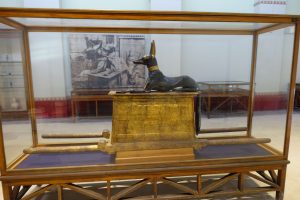
The dog god Anubis at the Egyptian Museum in Cairo. Photo by Lance Woodruff
Amanda Kelly, Fwaggle Toy Manchester Terriers in Canada, and host Laura Reeves take a deep dive on the history of purebred dogs. From the Victorian era, through the Industrial Revolution to today, we discuss how and why purebred dogs developed and how preservation breeders are curating living history through purebred dogs.
“I think that (Meen’s quote) is such a profound statement,” Kelly said. “Because it speaks to two things for me and there’s a tension between them. One is, it talks about the reasons why preservation is so important. We preserve our breeds because we love them, which is always going to be the number one reason that we do anything in the dog world. But there’s a broader purpose. There’s a broader service to society in preserving some of these breeds, particularly the very old ones. In that we are the ones who are maintaining this living museum.
“We are the ones who can show to a 10-year-old interested in ancient Egypt a dog that maybe looks exactly like a dog that sat next to Cleopatra… We can talk about the history of the country. And we can put a living artifact in front of people.
“I think the importance of artifacts and touch points that allow people to not just read above something, but to have an emotional and physical connection, is maybe a little bit more present for me when it comes to dogs, because I think that as a tool we are telling the story of our history on this Earth.
“Dogs have a really particular way of doing that because they speak not only to the things that they did for us, which in turn tells us about the way that we lived in different times and in different places in our history, they also allow us to actually feel a connection to that time you just can’t get through words on a page.
“What Doctor Meen said also speaks to the concept of evolution… all of these animals, whether they were developed in one part of the world or another part of the world, they all come from a place. We didn’t arrive in 2000 with 400 plus dog breeds that just magically rained down from on high. These were purposely developed animals in whatever area of the world and for whatever reason they were developed.
“They reflect the hand of humans who were the ones that were choosing them. Whether we’re talking about 500 years ago when they were being selected for behaviors that helped people actually live. I mean, people relied on these animals in order to be able to put food on the table.
“So, whether you’re talking about that or you’re talking about perhaps a companion dog that was developed by the Victorians because it was cute sitting on a pillow, it doesn’t make any difference why it was developed. But as part of that living museum. We are also reflecting that we have developed these animals through this concept that I talked about earlier, which is this idea of evolution with intent.”
“So 2021 is a whole lot different than 1821 or 1921. And it has different things that are important to the people in this society. And I think it is noteworthy that dogs, in some format or another, are still one of those things. They are one of the through lines of all of our history,” Laura noted.
“The concept of preservation breeding is a really important one,” Amanda added. “And thinking about what is it that we’re preserving and how we do that most effectively.
“But I think as groups of breeders we have to think more about where our breeds are going to be in 50 years and how we’re going to make sure that they’re still here. And that may require us to make hard choices. It may require us to make backup plans and to plan breedings that have alternate agendas other than producing your next best in show winner and those are hard things.
“If you’ve devoted your entire life to a breed. And the difference is that you can’t crop it or you can’t dock it. Or perhaps both, depending on your breed. Would you be willing to not only not have that breed in your life? But to actually see it disappear completely because of that.”
I don’t know the answer, but that is the question.
342 – History: To Understand the Present, Must Know the Past
History: To Understand the Present, Must Know the Past
Lesley Hiltz, long-time Beagle breeder and conformation judge, details a new history project launched by Beagle enthusiasts worldwide.
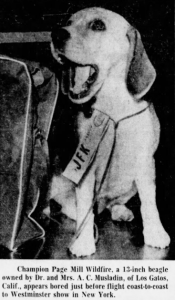 “The Beagle History Resource is a non-profit website with the aim to preserve the history of beagles and the community surrounding it for the future. All is maintained by volunteers and beagle enthusiasts, and we rely purely on donations to keep the service free for the public,” according to the website.
“The Beagle History Resource is a non-profit website with the aim to preserve the history of beagles and the community surrounding it for the future. All is maintained by volunteers and beagle enthusiasts, and we rely purely on donations to keep the service free for the public,” according to the website.
The driving forces behind this initiative are: Toke Larsen from Denmark, Hiltz from the USA, Jonathon Willis from New Zealand, and Alice Cancikova from the Czech Republic. Additional volunteers are needed, Hiltz noted. Email the committee to help in any way, she added.
Saved to the cloud
Hiltz praised Larsen for his technical skill and abilities to preserve history utilizing the “cloud” into perpetuity “or whatever comes next.” The website has the capacity to host photos, writings, and other documents.
Other breeds also have developed similar concepts, including:
https://whippet.breedarchive.com/home/index
Beagles at sea
Hiltz’ story of transporting two of her early Beagles from England to Australia via cargo ship is mesmerizing and puts all current import/export complaints in context. Actively involved in Beagles since the early ‘60s, in Australia, England, and the United States, Hiltz offers a wide-ranging and compelling narrative of her personal history in the breed.
Preserving her breed and its history is the driving force for Hiltz in working on the development of this online resource. But she envisions it as an opportunity to develop a worldwide, all-breeds repository.
“I can envision a kennel club taking up this project and having a central location for all of the information that’s out there,” Hiltz said. “To understand the present, we must know the past.”
330 – Breeding Rules from John Buddie, Tartanside Collies
Breeding Rules from John Buddie, Tartanside Collies
John Buddie has spent a lifetime with Collies. His Tartanside family of dogs is world-famous and widely respected. His Breeding Rules are a distillation of more than 50 years of experience and success. This is part one of a two-part series.
Buddie’s original breed mentor gave him much of the knowledge he continues to share today.
“This was mentorship in the days of letter writing, plus weekends spent doing kennel chores, brushing dogs, really hands on work,” Buddie said. “When I asked a question, she would ask me a question to make me think.”
Spoon-feeding someone an answer doesn’t have the same impact as helping someone come to their own conclusion, Buddie observed.
Buddie’s “rules” are guidelines that are applicable across breeds and generations.
*Leave the sport/breed no worse than you found it
Show respect for the lines and breeders who came before by preserving that quality.
*The number of champions finished/ribbons earned is not the measure of a breeder
“There have been many important contributing breeders who changed the face of a breed who bred on a small scale,” Buddie said. “For every record achieved there will always be someone who can break that record.”
*Learn to read a pedigree
Research, look to breeders of the past, learn what they accomplished and how.
*Look to the grandparents
Most top producing dogs are just carrying the pedigree forward. Top sires, often the strength comes from dam side.
“I’ve had great success using the Maternal grandsire effect, in other words breed a quality bitch to her maternal grandsire,” Buddie said.
*You can never outrun a problem
“It’s a lot easier to rid yourself of problems with testing now. But you have to admit the problem and deal with it. It can mean scrapping a couple generations of breedings to clear it out. But you have to protect your breeding program as a whole.”
*Learn to see quality in other people’s dogs
“We make evaluations of dogs when we’re competitors… when you’re judging you realize you weren’t as open-minded as you thought you were.”
*Attend national to see dogs that you wouldn’t see any other time
Join us next week for the continuation of this fabulous conversation.


